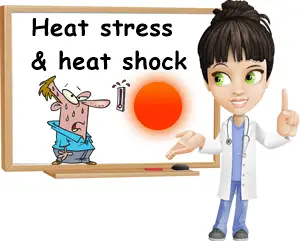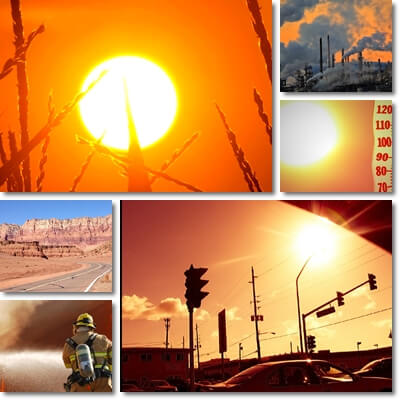Heat stress is a form of thermic/thermal stress that occurs when a person is exposed to high temperatures, usually from environmental sources. Common causes include hot weather, high humidity, living or working in proximity to heat sources, strenuous physical activities performed in a hot environment, whether indoors or outdoors. Symptoms of heat stress include profuse sweating, thirst as a first sign of dehydration followed by difficulty focusing or performing various tasks, fatigue, muscle cramps, overheating sensation, increased heart rate and ultimately loss of consciousness/fainting.
The longer the exposure to high temperatures or hot environments, the less able the body is to regulate its internal temperature. As a result, it continues to store heat which causes its core temperature to rise. And it is this rise in body temperature that affects its ability to function optimally, ultimately leading to a shutdown. Treatment involves removing the person from the hot environment, removing heat sources and offering water for rehydration, followed by helping them cool down, slowly and steadily (to avoid cold shock). Medical help should be sought after immediately.

What is heat stress?
Heat stress basically refers to overheating. It occurs when the body cannot regulate its internal temperature and keeps accumulating heat. It is the first of three stages of overheating and the least serious – the other two stages of overheating, in order of their severity, are heat exhaustion and heatstroke. In a broader sense, the definition of heat stress may also extend to include heat exhaustion and heatstroke. Heat stress bears medical significance and can have serious health consequences if not addressed in time and accordingly.
How does heat stress happen?
It all has to do with how the body reacts to heat. When environmental temperatures are high, core body temperature rises as a result. In response to this rise, certain metabolic mechanisms are set off to help the body cool down, such as perspiration. But there are limitations to such mechanisms and, if exposure to high temperatures continues for too long, a person is ultimately unable to regulate its core body temperature and there will be more heat gain than heat loss.
A higher than normal core body temperature (and rising) is detrimental to health and will cause a gradual shut down of life-sustaining processes. If a person is also doing physical work, then there is additional heat production which further contributes to the rise in core body temperature. Wearing protective equipment can add to the heat production, while a humid environment can limit heat loss from perspiration, adding to heat stress.

What causes heat stress?
The causes of heat stress include the following:
1) Hot weather: high temperatures and high air humidity.
2) High indoor temperatures due to lack of air condition or ventilation, proximity to heat sources (radiators, furnaces, stoves, boilers etc.), overcrowding.
3) Certain occupations. Firefighters, miners, construction workers, farmers, athletes, bakers, kitchen workers, metal workers and factory workers in general as well as those doing physical work outdoors are all at risk of heat stress.
4) Occupations that require heavy protective equipment (which prevents heat loss through evaporation from perspiration).
5) Poor or inadequate hydration and dehydration.
Certain groups of people are more likely to develop heat stress more easily: babies, small children, the elderly, people with chronic conditions and anyone engaging in intense physical activity outdoors or indoors.
What are the symptoms of heat stress?
Heat stress symptoms include the following:
1) Overheating sensation (hot skin) from rising body temperature.
Can be experienced as a more general sensation or localized at first (head, forehead, chest, torso, hands, feet).
2) Sweating, often profuse.
3) Skin rash from sweating (heat rash): appears as red patches or groups of red bumps.
May be accompanied by itching, especially in folds of skin.
4) Dehydration (loss of fluids as a result of intense sweating; also loss of salts/electrolytes).
5) Muscle weakness and muscle spasms and cramps (from dehydration, electrolyte imbalance).
6) Excessive thirst (caused by loss of fluids) or thirst that cannot seem to be quenched with plain water (caused by loss of electrolytes – sodium, magnesium, potassium, calcium).
7) Rapid heart beat/rapid heart rate: above 100 heartbeats per minute.
Followed by heat exhaustion symptoms – which is sometimes seen as another stage of heat stress.
8) Headache.
9) Difficulty concentrating on tasks or completing tasks.
10) Generalized weakness.
11) Fatigue.
12) Lightheadedness, dizziness, irritability, lethargy.
13) Cold, moist, sticky skin or red, dry, hot skin.
14) Nausea, vomiting sensation.
15) Fast breathing.
Lastly, heat stress can progress to heatstroke which includes the following signs:
16) Extremely high body temperature.
17) Loss of consciousness.
18) Seizures.
Heatstroke can cause disability or worse if not addressed in time. Requires immediate medical attention.
How to prevent heat stress
1) Stay hydrated by drinking plenty of water and have water with you at all times when it’s hot.
Know that the body’s fluid requirements grow the higher the temperatures.
2) Make sure you are getting enough electrolytes such as potassium, magnesium (especially if you are sweating a lot). Rehydrating sports drinks can help.
3) Give yourself time to acclimate to hot climates, hot weather or working in high temperatures.
4) Allow yourself to rest more frequently when it’s hot. Lie down if you’re feeling tired.
5) Avoid being outside when it’s too hot (avoid being outside between 11 a.m. and 3-4 p.m.).
Reschedule outdoor activities for the cooler part of the day or move them indoors if possible.
6) Avoid being in direct sunshine – it increases the chances of heat stress.
7) Make sure there is adequate ventilation indoors or air conditioning to help you keep cool.
8) Wear loose-fitting, light clothing made from breathable fabrics such as cotton and hats.
9) Eat little and often. Choose light, fresh foods. Keep yourself hydrated with soups, teas (no caffeine), fresh fruits and vegetables. Avoid caffeine and caffeinated beverages (coffee, green tea, black tea, white tea) as well as fried food and fast food.
10) If you’re out in a heatwave, go to public libraries, cafes, malls or shopping centers or anywhere with air conditioning.
11) Avoid driving in hot weather conditions if you don’t have air conditioning.
Treating heat stress: solutions
While it’s better to prevent heat-related illness than to treat it, if you experience symptoms of overheating, you can:
1) Rehydrate: water, sports drinks, herbal teas (but not with caffeine), fruit juices, oral rehydration solutions if needed.
2) Retreat to a cool place such as a coffee shop, shopping center, library, anywhere with air conditioning. Alternatively, seek shade under a tree.
3) Cool down slowly and steadily. Use wet towels on hands or arms, feet or legs, forehead or chest to cool down. Ice packs wrapped in a towel can be placed under armpits. Put feet (and only feet) in cold water. If you’re not too overheated, take a lukewarm or slightly cool shower. Avoid extreme differences in temperature to prevent a cold shock.
4) Keep cool by using a fan, drawing curtains, turning on air conditioning, wearing light, loose-fitting clothing.
5) Seek medical help if you feel you need it or, for example, if you experience unusual fatigue, dizziness, nausea, vomiting sensation, rapid heart rate and fast breathing or feel as if you are about to faint.
